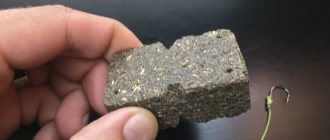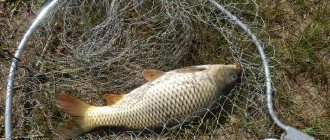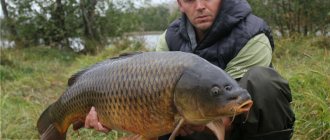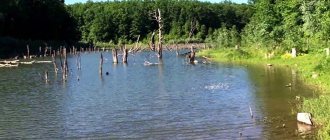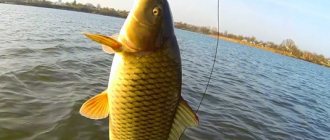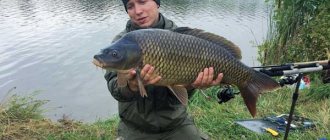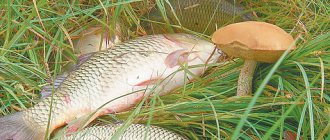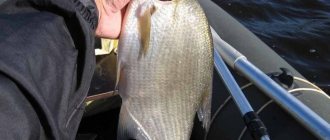Who can you catch for bread?
This simple bait turns out to have many clients in the school of fish. Various inhabitants of our reservoirs are not averse to eating dry crust.
Here's someone who would be happy to eat properly prepared bread for fishing:
- verkhovka (serka, verkhovka);
- roach (rudd);
- bream, white bream, silver bream;
- crucian carp of all types;
- carp, carp
These are the main hunters for this simple fish delicacy. Hunting for each species of these fish is a real art! You need to know the habits of each fish. Be able to properly prepare not only bait from bread, but also an attractive bait from bread for fishing. Know exactly the habits and preferred habitats. In order not to miss the fish, when all the ingredients have already been prepared and everything you need has been prepared, you need to know the characteristics of the bite of each of these species for bread. It is necessary to accurately prepare the tackle for each fish, because this too has its own characteristics. A nimble top-swimming fish will never be tempted by bait mounted on hook No. 5 for crucian carp. And the tackle that catches redfish simply won’t support a decent crucian carp weighing 600 grams.
For the most part, fishermen use bread crumbs. But bread crust, when properly processed, works great. You just need to know how.
Flavors
In bread crust fishing, aromatic substances are widely used to activate the bite and keep the fish in the baited area. Flavors are available in powder form, sprays, and dips. Powdered flavors are mainly used to saturate the smell of bait; sprays are sprayed onto bait or bait; baits are immersed in dips. In addition, they produce liquid attractants for impregnation of baits and baits.
The scent is selected depending on the preferences of the particular fish species.
How to make bait from bread
So, the fisherman had ordinary bread at hand.
Of course, you can just pour it into the water and forget about it. But you can find more useful uses for it. Let's start with the question of how the bait is prepared. The easiest way is to simply crumble stale bread into water. But you can also make a real fishing bait.
To do this you will need the following ingredients:
- Regular bread.
- Sunflower oil.
- Cake.
- Semolina.
- Anise flavor.
This is an ideal kit for preparing good bait. And the listed ingredients are always in the fisherman’s backpack. Well, now even a beginner will have them.
Carefully cut off the peel and soak it in water. Moisten the bread crumb just a little. When the crust softens well and turns into porridge, squeeze and drain the liquid. Add the crumb to the mixture and stir. Pour in a tablespoon of sunflower oil. This must be done in a separate container. For example, in a camping pot. Pre-soak the cake in a bucket. Pour the resulting bread mass from the kettle into a bucket and add a couple of drops of flavoring. To stir thoroughly. To be honest, there are no strict proportions. Approximately equal shares are taken. The bait is kneaded until smooth. At the end, semolina is added to the mixture and everything is mixed again. Then let the bait stand for about an hour until the semolina swells. Form the bait balls and you're done. Can be sent to a pond.
Fishing methods
Catching carp is carried out in two ways - from the shore and from a boat. In deep-sea reservoirs with fast currents, it is advisable to catch carp from a boat; for this you will need a durable spinning rod equipped with a reel. Those who prefer to catch this fish from the shore will need a fishing rod with the longest possible rod and an equally powerful reel.
You can catch carp with nets, but you need to do this from a boat or boat.
How to increase the catch of carp?
To ensure that the carp bites better and the catch is greater, it is advisable to feed the fish in a marked place several days before fishing. Carp will love this free canteen, and much more fish will accumulate in these places.
How to catch someone
So, the bait is ready.
Now the fun part begins - fishing for bread. The bread bait is made according to the order listed in the previous chapter. Divided by depth to which the cast will be made:
- The surface is high melting.
- At medium depths there are roaches and bream.
- Along the bottom - crucian carp, bream, carp.
The verkhovka (verkhoplavka, serka) walks along the surface itself. To catch it, a fishing line with a thickness of 0.15-0.20, a small hook of 3-3.5 in size and a light float balanced by a corresponding weight are placed on a fishing rod.
Bait
Pieces are plucked from the slightly moistened bread crumb and rolled into balls the size of a match head. They are put on the hook, slightly covering the sting. Now the question is how to catch it. The hook is released to a depth of 10-15 centimeters. Just pour dry crumbs into the water and start the fun. The serka bites sharply. The peculiarity is that the little fish play a lot with the bait and the float dances on the water like crazy. The main thing here is to catch the moment when it suddenly goes under the water and hook it.
Now more serious prey - white bream, rudd, roach. In this case, catching fish with bread is a little more difficult. These fish stay at “half water,” as fishermen say. This means that you need to set the depth at which the bait will be located approximately halfway between the surface and the bottom. The hook goes 3-4. Medium float. Maybe a pen. Feed with a preparation that you prepared for fishing with your own hands.
Bread bait again
There are slight differences here. The same crumb comes with different flavors. For example, bread with garlic, with anise, with vanilla. No more ingredients. The pellets are made the size of a small pea. A little elongated. These breeds do not bite very quickly. Usually the float moves to the side, slowly sinking. Hook when completely submerged.
Heavyweights on the crust
Well, the most serious bottom specimens.
Crucian carp, carp, bream. They make a special bait from bread. The crumb and crust are moistened and kneaded into plasticine or dough. Cake is added to it, kneading thoroughly, and a couple of drops of anise or barberry. It's good to add a little flour. The ball should be elastic, but it should not instantly crumble in the water. Use bean-sized pellets. These fish need to be caught from the bottom. That is, a hook baited with bread lies freely on the bottom, as does the load of gear. The goose feather float stands with a slight inclination. Line on the base 0.45. On a leash from 0.3 to 0.4. Hook starting from 5.
bait balls are thrown. One per fishing rod.
orybalke.com
The process of carp breeding has led to the emergence of several breeds that differ from each other not only in body structure, but also in scales. The body shape of carps is elongated and humpbacked. Some have a full scaly cover, while others (mirror) have a couple of rows of large scales.Thanks to their high fertility, carp proliferated very much and became the object of mass fishing. After several generations, a breed of so-called wild carp appeared. And this “fish” can most likely only be compared in weight to catfish. Carp is an unpretentious fish, so they managed to breed it even in those places that were completely indifferent to it both in terms of temperature conditions and the presence of this or that reservoir soil. The “classics” claimed that carp love warm, silty bodies of water without a current, but in fact it turned out that this is not entirely true. They are much more fond of bodies of water in which there is something to eat. The growth rate of carp depends solely on the abundance of food. Nowadays, amateur fishermen do not feed the carp as well as in the old days (with buckets of potatoes, pearl barley and millet porridge), but they still pamper them a little so as not to be left without a catch.
For a sports fisherman, carp fishing is an interesting activity that requires not only skill and endurance, but also dexterity. Catching a large carp on a hook is a great success, real happiness for a true fisherman. When fishing, the carp exhibits such strong resistance that sometimes it wins the fight with the fisherman. It doesn’t cost a carp anything to break a bamboo rod, break a fishing line with a cross-section of 0.5 mm, or simply straighten the hook. Those fishermen who catch carp professionally know that this fish is very smart and careful, so the gear used for carp fishing must meet the highest requirements. If I fish with bamboo rods, the length of the rod should be at least 5 m.
You should take a rod that has high rigidity and great elasticity. The upper leg of the rod should not be too thin. The rod should quickly tire the fish and prevent it from getting into the reeds or under snags, from where the carp can no longer be reached.
Tackle for catching carp with bread crusts in ponds overgrown with grass.
The tackle is mounted like a bottom fishing rod with a sinker at the end of the line and two hooks on leashes. This tackle differs from a bottom fishing rod in the length of the leashes and the weight of the sinker, which is 100-150 g. The length of the leash depends on the depth of the reservoir. The gear is used to catch carp using a crust of bread floating on the surface of the water among aquatic vegetation. Therefore, the length of the leashes should be such that the crusts float freely and do not submerge in the water.
The first leash is tied to the main line 2-3 m from the sinker, its length is 1.5-2 m, the length of the second leash is 1-1.5 m. The thickness of the main line is 0.5 mm, the leashes are 0.25-0.35 mm. When using this tackle, the main attention should be paid to the choice of nozzle and the position of the hook in it. It is better to take stale bread that has lain for 3-4 days, preferably without crumb. A cube measuring 1 cm3 is cut out of the bread, into which a hook is sequentially inserted through all 4 corners and a leash is pulled through. After the last puncture, the hook must be turned 180° and inserted into the cube so that when prying it, it completely goes into the crust. Using the gear described above, you must carefully camouflage yourself behind bushes, reeds, etc. growing on the shore. The carp bite is manifested by a characteristic splash and disappearance of the bait.
Rudd.
The rudd is found in rivers, lakes, and artificial reservoirs, lives in shallow water, in the thickest grassy areas of the reservoir, and leads an almost sedentary lifestyle. It spawns at a water temperature of 16-18 °C in small grassy places and feeds on algae shoots, slugs and other aquatic organisms.
The weight of the rudd reaches 600 g; it is caught with a fishing rod in the windows of grassy places and near reeds. The bait for catching rudd can be pieces of a worm, small balls of semolina, caddis flies, maggots, and bloodworms. As a rule, rudd is caught in the upper layers of water, and in bad weather it is also caught in deeper places. To avoid the hook getting caught in the grass and to ensure accurate casting of the bait, the rod is equipped with shorter line. In some cases, a jig is used instead of a hook.
When fishing for rudd, it is better to choose a feather float, and a small, sharp, hooky hook. The rod is light, no more than 3 m long, line thickness is 0.1-0.15 mm.
The best fishing time for catching rudd is early in the morning, quiet or with small ripples on the water, when it “grazes” on the edge of the algae.
Option two
The second way is to use a bread crust. Unlike crumb, the crust is used for fishing from the surface of the water, because has positive buoyancy. And, no less than the crumb, the aroma attracts fish.
The main condition is to choose the right type of bread. After all, carp is far from being to the taste of carp, which is not every grain product. For example, carp loves pita bread most of all. Lures made from lavash stick perfectly to the hook, allowing you to make even long casts.
How to keep on the hook
When fishing with a float, this attachment is easier to use. Planting bread using the “pinching” method has been popular for many years. Take a piece of crumb and stick it around the hook. Some people try to use very fresh bread products; they stick together better. Others, on the contrary, use a 2-3 day old loaf.
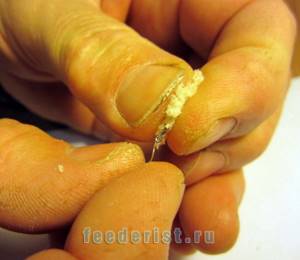
When this bait gets into the water it begins to swell and increase in size, which is very attractive to fish. Used for catching roach, crucian carp, and bream.
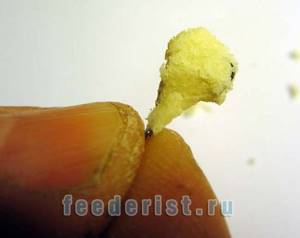
But this method is not applicable for bottom gear. The pinch will either fall off when the feeder splashes down or will not sink to the bottom.
Stores sell special die-cuts for fishing for bread. They come in different sizes to suit different fish.
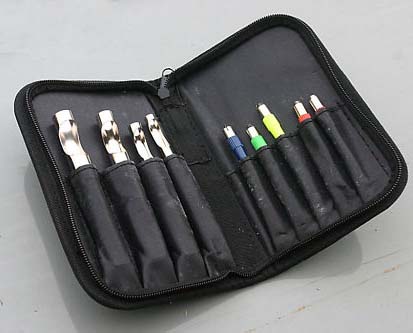
With this type of die cutting, the bread crumb is pierced one or several times, while the circles of pulp become denser and stick better to the hook. This method is used for both float and bottom fishing.
Crumb is good for long casts. It is done on the pond itself in a few minutes. Almost any bread will do, even dried out ones. It is first wetted (you need to wait until it is saturated with water), and then kneaded until it stops sticking to your hands and becomes like dough.
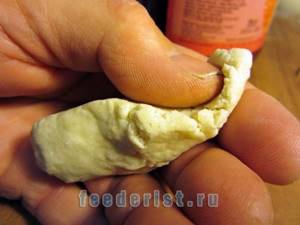
They use white, rye, Borodino bread, bagels, buns, and a combination of them. For fishing, you can knead the crumb together with steamed rolled oats, boiled potatoes, hominy for fishing or vegetable oil.
For the crumb it is better to use pulp, it then turns out homogeneous and sticky. But you can knead it together with the crust, then on the hook you can combine the harder parts of the crust and the soft ones. In general, in some regions they are caught simply on a crust of bread. Being buoyant, it can attract more attention from fish. You can combine the crust on the hook with the crumb.
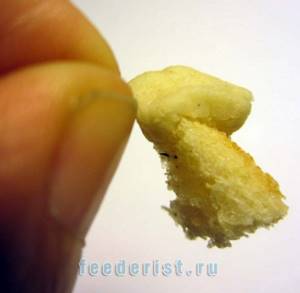
Lures for carp from lavash
Catching carp with lavash bait is the most preferred method. To make a nozzle, you need to stick a fish hook into a fairly large piece of pita bread, and then flatten it, forming it into a ball or drop.
Under water, the pita bread bait will swell, become soft, and its aroma will attract carp.
In the summer, especially in July, it is with bread bait or lavash that you can catch relatively large carp. Mostly carps up to 3.5 kilos are caught on bread.
Gear used
Rod
In general, almost any rod can be equipped for fishing with a crust of bread. There are references to fishing with a bottom fishing rod, light spinning rods and powerful rods for catching carp.
However, float rods are mainly used for fishing with crust of bread. There is a theory that a match rod with guides 5-6 meters long is best suited for this type of fishing.
fishing line
As a rule, monofilament thread is used as the main line for fishing with bread crust. The diameter depends on the size of the fish in a particular body of water.
Coil
The choice of reel depends primarily on the rod and the preferences of the fisherman. Typically, spinning rods are equipped with an inertial multiplier reel, while float rods are equipped with medium-power inertialess ones.
Float
When fishing with bread crust, as a rule, neither floats nor other bite alarms are used. Sometimes, however, a fisherman needs to sink the bait a little deeper, and he uses a water-filling float.
Sinker
You don't need a sinker for fishing with a crust of bread.
Leash
There is no consensus on whether it is necessary to equip a fishing rod for bread crust fishing with a leash; it depends on the conditions of the reservoir and the taste of the fisherman. If there is a leash, it is usually made of monofilament or fluorocarbon thread of a smaller diameter than the main line.
Hook
In addition to the main hook, two additional ones are often hidden in the bait, which the fish may not notice and thereby, having swallowed the bait, get hooked.
Dough for carp fishing
One of the good options for catching carp is dough. You can fish with dough not only in summer, but also in early spring and autumn.
Baits are made from wheat flour, without the use of additional additives. You can catch carp using dough even without pre-feeding.
When kneading the dough, you should monitor its consistency; the dough should turn out soft. Then it will stay on the hook better and will not arouse suspicion among the carp. However, when fishing for carp with dough, long casts are excluded, because... the bait will fly off the hook. For this bait, it is possible to fish exclusively with float gear.
If desired, you can add the following flavored components to the finished dough, which the carp cannot resist. These include cake, processed cheese, sunflower or hemp oil. After adding flavorings, mix the dough well again. Again, you need to make sure that it remains soft; the carp will simply ignore hard dough.
Catching carp with bread
Among all carp baits, bread takes an honorable first place. It is difficult to find another attachment with such versatile applications. They fish with bread from the surface, from the bottom and in the middle layers of water. It holds firmly on the hook and withstands casting well, but once in the water it quickly gets wet, becoming very soft and especially attractive to carp. Most often, a piece of bread with a crust, known as “bread crust” or simply “crust”, is used as bait. .
Such a crust, the size of a matchbox or slightly smaller, is cut with a sharp knife from a loaf of white or gray bread, fresh if possible.
There are many types of bread, but those that are suitable for making a crust are quite few, since the crust must be elastic, not too hard and not crumbly. Figure 1a shows how best to place the crust on the hook. In order not to waste time on the pond, we prefer to cut the crusts at home and take them with us fishing in a plastic bag.
If you drop anise oil or another fragrant product there, then along the way the bread will have time to thoroughly become saturated with its smell. You can prepare the crusts for future use. Try stringing the sliced rinds onto a knitting needle and placing them in the oven for a quarter of an hour at about 200°C.
When the resulting crackers have cooled, remove them from the knitting needle - here you have crusts for long-term storage, with ready-made holes for the hook. In water, dry crusts quickly soak and become soft, but are still inferior to fresh ones. Floating like a cork, a bread crust is an excellent bait for fishing from the surface. At the same time, with the help of sinkers, it can be lowered into the middle layers of water or to the bottom. Of course, it is first necessary to establish what kind of weight is required to compensate for the buoyancy of the crust and cause it to slowly sink.
Also interesting: Carp for corn
However, when fishing from the bottom, we prefer the crumb of freshly baked white bread (old bread is too dry and crumbles). Having placed a piece of crumb the size of a walnut on the hook, just taken out of the loaf, we squeeze it from the sides with our palms so that it can better withstand the upcoming cast.
In water, the crumb, if it was not compressed too much, swells to its original size, but, unlike dough, does not dissolve. This ephemeral, weightless bait is instantly absorbed by the carp and does not in any way interfere with hooking. On the contrary, carp that take the crumb very often hook themselves. Some experts make sure that the tip of the hook is not covered when baiting. Then even those carps that take a freshly thrown bait that has not yet had time to properly soak will be hooked.
A significant disadvantage of bread crusts and pieces of crumb is that they have to be renewed very often on the hook, because small fish tend to fiddle with them until they knock them off and eat them.
An inventive fisherman will find a way out of the situation here too. It is enough to tie the bread crosswise with thin darning threads (preferably light) or wrap it in a thin hair net so that its resistance to attacks from uninvited guests increases several times (Fig. 1 b). The hook is stuck into the bread under the crosshairs of the threads. When the bread swells, neither the threads nor the hook will be visible, so there is no fear of scaring the carp with the threads.
The other option is only suitable for crusts. Try cutting long, narrow strips of crust, about 10 x 1.5 cm, from a fresh loaf and rolling them into rolls. These unique rolls hold very tightly on the hook, but they have to be threaded using a special needle (Fig. 1c).
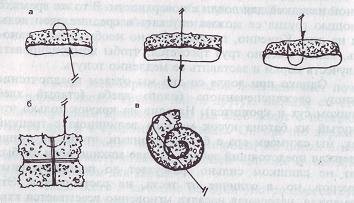
Rice. 1 Methods for placing bread crust on a hook
Finally, one last tip:
The crumb of unbaked white bread, taken out of the oven 15–20 minutes ahead of schedule, stays on the hook somewhat better than the crumb of ordinary bread. Of course, not every carp fisherman can regularly have unbaked bread at his disposal: you need to either bake it yourself or have a baker you know. Regular bread can be made somewhat more elastic by placing it in a plastic bag or wrapping it in a damp cloth, but it will still be worse than unbaked bread.
Category: Carp fishing
Fishing for bread and bread crumbs
The advantage of bread crumb is that this attachment is generally available, and the balls from it stick very well on the hook. True, it is rarely used in its pure form: fish sometimes treat this bait quite coolly, preferring various cereals, peas, and corn grains. However, the bite on bread can be significantly improved if you use suitable additives.
Adding Unifeed
Adding ordinary fishing food to the bread crumb enhances its attractiveness. The bait itself, however, does not hold well on the hook, becoming looser, so it is better to give the crumb the shape of a drop. For this combination they take crucian carp, carp, ide, chub, large roach, bream, silver bream, dace and other white fish.
Bread crust for bream
But it’s better to catch bream not with crumbs, but with a piece of crusty bread. Before fishing, pieces of bread are fried in a frying pan, and then square pieces are cut out of them so that the crumb is adjacent to the crust. It allows the bait to stay on the hook more firmly, and its decent size (1x1x1 cm) prevents small things from knocking the bait down, although there will certainly be attempts to do so.
Carp and carp can easily be used for bread crust. In this case, an even larger piece (with a side of about 1.5 cm) is hung on a hook than when fishing for bream.
"A cheese sandwich
To catch chub, you can mix bread crumb and grated cheese (Kostroma, cheddar, Edam) in equal proportions. The best method of fishing with such a bait is a running donka.
Bread with garlic for crucian carp
Adding a very small amount of garlic to the bread crumb (literally at your fingertips) will attract crucian carp to your baits. And if you add a “garlic” additive to your bait or bait, then it is quite possible to interest all the crucian carp living in the pond.
For those with a sweet tooth
Mixing crumbs from honey gingerbread or “black” gingerbread into the crumb increases the likelihood of bites from crucian carp, as well as carp and carp. These fish have a “sweet tooth” and are partial to honey. However, try not to abuse its quantity. A bait that is too sweet will scare rather than attract fish.
Store-bought flavors
To enhance the bite, you can mix various flavors into the bread: vanilla, dill, strawberry, banana and others, which are offered to fans by fishing stores. Before use, carefully read the instructions: how much aromatic mixture should be added, what time of year it works, what fish it is intended for.
When using fragrances, remember that they only work well for one day. If you plan to fish for several days, then the bait must be prepared every day.
Vegetable oils
Garlic, hemp, flaxseed, unrefined sunflower, and, of course, anise oils added to bread crumb have been used by fishermen since ancient times. Since then, little has changed: just like in the old days, adding a small amount of these oils to bread provokes fish to bite more actively.
With porridge
An excellent attachment is obtained by mixing bread crumb with millet or oatmeal porridge in a 1:1 ratio. The crumb makes the bait more viscous, and it stays on the hook better. Millet is one of the most attractive baits for carp, crucian carp and bream. A mixture of bread and oatmeal porridge will attract carp to the bait. However, the bream can ignore this bait.
Crust or crumb?
They also catch fish such as chub and ide on bread. Moreover, fishermen often argue about how best to catch these fish: with a crust of bread on top or with crumbs in the water column. In my experience, both methods are effective. Only you need to use them at different times of the year. In spring and autumn it is still better to fish at the bottom, and the bite on top is more likely in the summer.
Bread with potatoes
A bait consisting of equal parts of rye bread and mashed potatoes is practically a win-win when fishing for carp and carp. Especially if you flavor it a little with unrefined sunflower oil.
With animal bait
Bread crumb is used, as well as dough when fishing with “sandwiches”. The dough in combination with maggots, bloodworms or a piece of worm evokes the appetite of the same white fish.
True, you need to make “sandwiches” in different ways. In the “maggot-crumb” combination, the maggot is placed on the hook first, and the tip of the hook is covered with bread.
If you are fishing with the “crumb-bloodworm” or “crumb-worm” combination, first hang bread on the hook, and then cover the tip with animal bait.
Some fishermen, for example, do not bother with baiting two different baits, but simply mix crumpled fish into the bread.
Types of bread baits for carp
One of the simplest and most inexpensive ways to prepare bait is to use regular white bread. You should not simply cut a piece of a certain shape from the product and stick it on, as this is not effective. The fish simply takes the bait. Therefore, let's consider options that are more effective. Fans of carp fishing use several popular methods for making bread baits; let’s look at some types of them as an example.
Crumb
This type of bread bait has been used by fishermen for a long time; it is very simple to make. To prepare you need:
- Remove the soft part from under the crust of the bread.
- Place it in water, preferably collected from the same reservoir.
- Wait a little until the pulp absorbs moisture.
- The mass needs to be squeezed out, this is done by hand. Most of the water needs to be removed. The result will be a plastic substance similar to dough.
- Small balls are formed from the resulting substance and placed on a hook.
As an additional option when preparing such bait, add the following to the water or directly to the bread pulp:
- flavorings;
- cake;
- small cereals;
- pea flour.
When adding additional ingredients, it is necessary to take into account that there should not be a lot of them, as this may scare away the cautious carp.
Bread crusts
To prepare this type of bait you need:
- Using a knife, cut out small cubes of bread crust with a small amount of pulp from the bread or loaf. Since the crust is very dense, it takes a long time to soften and swell in water.
- Pass the hook through the crust, then hide the tip and body of the device in the pulp.
In this case, carp fishing takes place in the bottom layers of water, since the bread crust is very light before it gets wet and floats up with the hook. The position of this bait in the water can be adjusted by the length of the leash or by moving the sinker. You can also fish from the surface of the reservoir, in places where carp are actively feeding nearby and can be visually detected. Most fishermen prepare the crusts at home and put them in a plastic bag, which they take with them when fishing. Various flavorings are added to the package:
- sunflower oil;
- anise drops;
- and other odorous substances.
This allows you to make the bait more attractive. You can also prepare bread crusts in reserve. They are cut out of bread or loaf, making a hole in them with a knitting needle in advance. Drying is done in the oven or left to dry in the sun. The resulting baits are stored for a long time. While in water, the crusts soak and become softer.
Bread "tablets"
A very catchy, denser bait, which was invented by fishermen in the process of improving the crumb. As a result, the bread “tablet” stays on the hook for a long time and does not get soggy for a long time. When making this type of bait, it is also possible to use flavors that will make it attractive. It is possible to compare this bait with boilies popular among carp anglers. Sometimes “tablets” work more successfully than branded boilies.
How to catch more fish?
I have been active fishing for quite some time and have found many ways to improve the bite. And here are the most effective:
- Bite activator. Attracts fish in cold and warm water with the help of pheromones included in the composition and stimulates its appetite. It’s a pity that Rosprirodnadzor wants to impose a ban on its sale.
- More sensitive gear. Reviews and instructions for other types of gear can be found on the pages of my website.
- Lures using pheromones.
You can get the rest of the secrets of successful fishing for free by reading our other articles on the site.
Prepare bread tablets as follows:
- Cut the bread or loaf crosswise and cut off two pieces one centimeter thick.
- Cut off the crust of the bread around the perimeter from these pieces.
- Use a rolling pin to compact the bread on both sides.
- On one side they are coated with honey (condensed milk, sunflower oil). You can also crush and add garlic or other fragrant ingredients.
- 2 pieces are combined and passed with a rolling pin again.
- Now the pieces need to be given the required shape. You can simply cut them into small squares, similar to lozenges.
You can put several “tablets” on a hook, or you can attach them to a separate hair, like boilies. Such bait can stay in the water for about an hour without getting wet. Bread “tablets” have proven themselves very well among fishermen.
Tactics when fishing for bread
In conclusion, I’ll tell you about some features when fishing with bread baits.
Only near residential areas
Firstly, it’s worth mentioning right away that in reservoirs that are rarely visited by fishing enthusiasts, fishing for bread is unpromising, and sometimes even simply useless. Fish in these places (oxbow rivers remote from habitation, forest lakes, silted ponds) simply ignore bread baits, clearly preferring bait from their daily diet - bloodworms, worms or insects falling into the water.
The most likely places where carp will bite well on bread are places where this bait is familiar to the fish: ponds, lakes and rivers located or flowing near residential areas.
Suitable places for fishing for bread
The interest of underwater inhabitants in bread can vary even within the same body of water. Basically it all depends on the place where you offer this bait to the fish. For example, an excellent bite on a piece of bread crumb is possible near bridges on rivers or dams, on ponds where, due to circumstances, bread often falls into the water.
They will also peck at bread in the area of bathing areas, in places where they rinse clothes (for example, bridges within populated areas), and on river currents near banks with a clean bottom.
Where is it better not to fish for bread?
But in silted bays or rivers with a weak current and a coastal strip heavily overgrown with algae, bites for bread are rare. Bites on bread baits are also bad in fast currents: here the fish simply does not have time to eat the piece of bread offered to it.
Catching carp and carp on the makushatnik
Carp and carp bite well on bread crumbs and one of the favorite dishes of carp and carp is makha (cake). Therefore, fishermen came up with a special equipment called a makushatnik.
Bread crumb is one of the baits for carp that does not require any modifications. To catch karma from the surface of the water, use a crust cut into a square with sides of 4 centimeters. The bread should be fresh and the crust should have some crumb.
Smoothly sinking bread flakes are used as complementary food, which are often combined with other products. Of the huge selection of cotton products, only those containing unground grains or nuts are not suitable.
If you use bread as bait, then the best option would be gray rye bread. From the crumb of white bread you can make something like a boilie (roll it into a ball, it’s better for serving, add color, and add flavor with flavorings).
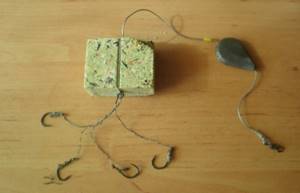
To catch carp and carp using cake, a bottom rig called a makushatnik is used.
The figure below shows the design of that same makushatnik.

Equipment: 1-fastener; 2-top; 3-sink-sliding; 4-bead.
This equipment uses sliding weights (river-100g, lake-50-80g). On lakes, instead of weights, spring feeders are often used, which are filled with porridge and cereals - this creates additional bait for carp and carp.
Installation. It is necessary to thread the leash through the hole in the center of the crown itself. Then you need to thread it through the clasp and return it back to the hole. Then the leash is tightened so that the clasp closes the hole on the top of the head.
During casting, the sinker slides along the line to the cake cube, but in the water it, as a rule, moves away from it.
All fishermen place hooks differently, I use two hooks and stick them into the crown. This way I avoid premature hooks and the hooks don’t get tangled.
After the cake begins to wash out, the hooks are released and the carp that came up to feed will eat the hook along with the top.
Sometimes I use a foam ball to raise the hook above the top of the hook. This increases the likelihood of a bite slightly.
Some fishermen bait their hooks with maggots or worms, but then small fish begin to bite.
Principle of operation
When it falls to the bottom of a reservoir, the masha begins to get wet, emitting an aroma. After half an hour, it begins to crumble into small and large pieces. It attracts fish with its aroma and particles and it begins to feed.
When going fishing, prepare your fishing rods in advance so that you have at least 2 ready-made fishing rods per rod. Replacing the tackle on a fishing rod itself is a quick task, but to prepare the makushatnik it takes a fair amount of time.
To summarize: cake can be purchased from oil producers or you can buy makushatniks in fishing stores (by the way, they contain many different crops).
But for makuha, the quality is important, not its composition. It must have average (universal) solubility in water. For rivers you should use slow-dissolving ones, and for lakes medium-fast ones. Share on social networks:
